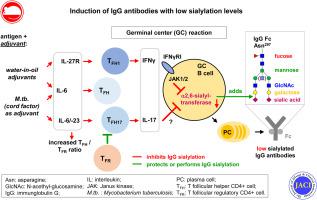Journal of Allergy and Clinical Immunology ( IF 11.4 ) Pub Date : 2020-05-21 , DOI: 10.1016/j.jaci.2020.04.059 Yannic C Bartsch 1 , Simon Eschweiler 1 , Alexei Leliavski 1 , Hanna B Lunding 1 , Sander Wagt 2 , Janina Petry 1 , Gina-Maria Lilienthal 1 , Johann Rahmöller 3 , Noortje de Haan 4 , Alexandra Hölscher 5 , Raghu Erapaneedi 6 , Anastasios D Giannou 7 , Lilian Aly 8 , Ryota Sato 9 , Louise A de Neef 4 , André Winkler 10 , Dominique Braumann 11 , Juliane Hobusch 1 , Kyra Kuhnigk 1 , Vanessa Krémer 1 , Moritz Steinhaus 1 , Véronique Blanchard 12 , Timo Gemoll 13 , Jens K Habermann 13 , Mattias Collin 14 , Gabriela Salinas 15 , Rudolf A Manz 16 , Hidehiro Fukuyama 9 , Thomas Korn 17 , Ari Waisman 18 , Nir Yogev 19 , Samuel Huber 7 , Björn Rabe 20 , Stefan Rose-John 20 , Hauke Busch 21 , Friederike Berberich-Siebelt 22 , Christoph Hölscher 23 , Manfred Wuhrer 4 , Marc Ehlers 24

|
Background
Effector functions of IgG Abs are regulated by their Fc N-glycosylation pattern. IgG Fc glycans that lack galactose and terminal sialic acid residues correlate with the severity of inflammatory (auto)immune disorders and have also been linked to protection against viral infection and discussed in the context of vaccine-induced protection. In contrast, sialylated IgG Abs have shown immunosuppressive effects.
Objective
We sought to investigate IgG glycosylation programming during the germinal center (GC) reaction following immunization of mice with a foreign protein antigen and different adjuvants.
Methods
Mice were analyzed for GC T-cell, B-cell, and plasma cell responses, as well as for antigen-specific serum IgG subclass titers and Fc glycosylation patterns.
Results
Different adjuvants induce distinct IgG+ GC B-cell responses with specific transcriptomes and expression levels of the α2,6-sialyltransferase responsible for IgG sialylation that correspond to distinct serum IgG Fc glycosylation patterns. Low IgG Fc sialylation programming in GC B cells was overall highly dependent on the Foxp3– follicular helper T (TFH) cell–inducing cytokine IL-6, here in particular induced by water-in-oil adjuvants and Mycobacterium tuberculosis. Furthermore, low IgG Fc sialylation programming was dependent on adjuvants that induced IL-27 receptor–dependent IFN-γ+ TFH1 cells, IL-6/IL-23–dependent IL-17A+ TFH17 cells, and high ratios of TFH cells to Foxp3+ follicular regulatory T cells. Here, the 2 latter were dependent on M tuberculosis and its cord factor.
Conclusion
This study's findings regarding adjuvant-dependent GC responses and IgG glycosylation programming may aid in the development of novel vaccination strategies to induce IgG Abs with both high affinity and defined Fc glycosylation patterns in the GC.
中文翻译:

用不同的佐剂免疫后,在生发中心反应过程中调节IgG Fc唾液酸化。
背景
IgG Abs的效应子功能受其Fc N-糖基化模式的调节。缺少半乳糖和末端唾液酸残基的IgG Fc聚糖与炎性(自身)免疫疾病的严重程度相关,并且还与针对病毒感染的保护有关,并在疫苗诱导的保护中进行了讨论。相反,唾液酸化的IgG Ab显示出免疫抑制作用。
目的
我们试图研究在用外源蛋白抗原和不同佐剂免疫小鼠后的生发中心(GC)反应过程中的IgG糖基化程序设计。
方法
分析了小鼠的GC T细胞,B细胞和浆细胞反应,以及抗原特异性血清IgG亚类效价和Fc糖基化模式。
结果
不同的佐剂以特定的转录组和负责IgG唾液酸化的α2,6-唾液酸转移酶的表达水平诱导不同的IgG + GC B细胞反应,这对应于不同的血清IgG Fc糖基化模式。GC B细胞中的低IgG Fc唾液酸化程序总体上高度依赖于Foxp3 –卵泡辅助性T(T FH)细胞诱导的细胞因子IL-6,这里特别是由油包水佐剂和结核分枝杆菌诱导。此外,低IgG Fc唾液酸化程序依赖于诱导IL-27受体依赖性IFN-γ + T FH1细胞,IL-6 / IL-23依赖性IL-17A + T FH17的佐剂。T FH细胞与Foxp3 +卵泡调节性T细胞的比例很高。在此,后两个依赖于结核分枝杆菌及其脐带因子。
结论
这项有关佐剂依赖性GC反应和IgG糖基化程序设计的研究结果可能有助于开发新型疫苗接种策略,以在GC中诱导具有高亲和力和Fc糖基化模式的IgG Ab。











































 京公网安备 11010802027423号
京公网安备 11010802027423号